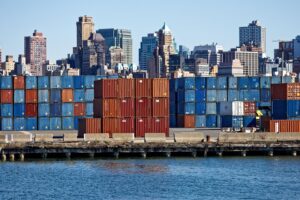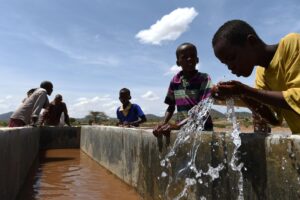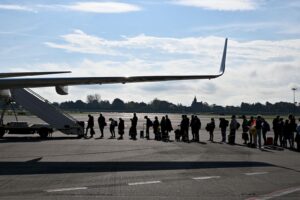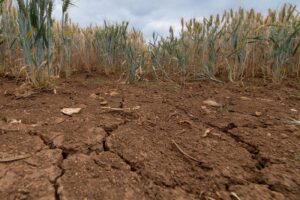The UK’s largest freshwater lake experienced its worst-ever levels of a harmful bacteria this summer.
Lough Neagh – a lake in Northern Ireland that is larger than the country of Malta – has been plagued by blue-green algae that can negatively impact humans, plants and animals.
A group of environmentalists recently held a “wake” to protest the scale of the situation.
Scientists tell Carbon Brief that agricultural nutrient runoff and climate change are the main roots of the problem – and that there is no “silver-bullet” solution.
In this article, Carbon Brief explains what happened on Lough Neagh this summer, how climate change made the situation worse and how it is being tackled without a functioning devolved government in place.
- What happened on Lough Neagh?
- What role does climate change have in the algal blooms?
- What is being done to improve the situation?
What happened on Lough Neagh?
Lough Neagh is the largest freshwater lake in the UK and Ireland, spanning around 380 square kilometres (km2). It holds more than 800bn gallons of water and stretches across five of the six counties in Northern Ireland.
The lake hosts a range of plant and animal species, including whooper swans, tufted ducks and the rare Irish Lady’s Tresses orchid. The wider 5,400km2 basin around the lake holds wildlife-rich wetlands.
The map below shows the scale of Lough Neagh compared to the rest of Northern Ireland.

Since May, high levels of a type of bacteria called blue-green algae have been identified in a number of rivers, lakes and coastlines in Northern Ireland. Lough Neagh has been particularly impacted.
These cyanobacteria – a type of bacteria that can photosynthesise – naturally inhabit freshwater ecosystems.
But if they get plenty of sunlight, CO2 and nutrients – such as nitrogen and phosphorus – they can grow in big numbers and begin to form visible algal “blooms”. The blooms negatively impact the appearance, quality and use of the water.
The recent blooms have affected swimmers and fisheries in Lough Neagh, which contains Europe’s largest commercial wild eel fishery.

It can cause rashes and illnesses in humans and can “potentially kill wild animals, livestock and pets if ingested”, according to the Northern Ireland Department of Agriculture, Environment and Rural Affairs (Daera).
The blooms also block sunlight from reaching other plants and use up oxygen in the water, which can suffocate fish and other creatures.
The image below shows the blooms visible from Copernicus satellite imagery on 4 September. The green swirls of algae are particularly noticeable on the eastern side of the lake.

Lough Neagh supplies around 40% of all drinking water in Northern Ireland. NI Water says that drinking water drawn from the lake remains “safe to drink and use as normal”.
The issue has had a political impact in Northern Ireland, where the devolved government has been at a standstill since last year due to Brexit-related issues.
The climate-sceptic former Northern Ireland environment and agriculture minister, Edwin Poots, said the blooms are a “very significant issue”.
What role does climate change have in the algal blooms?
There are a number of drivers behind the increase in algal blooms on Lough Neagh this summer.
This includes excess nutrient runoff from agricultural and wastewater systems, “combined with climate change and the associated weather patterns, such as the exceptionally warm June, followed by the wet July and August”, Daera says in a statement to Carbon Brief. The department adds:
“This is a complex, multi-factorial issue that will take years, if not decades, to solve.”
Studies say that excessive nutrients are the main cause of blue-green algal blooms in freshwater lakes around the world. Nitrogen and phosphorus occur naturally in water, but agricultural fertilisers, sewage run-off, household products and storm water flows can cause an overabundance of these nutrients

Algal blooms appear as a result of eutrophication – a process arising from too many nutrients in the water boosting the growth of plants and algae.
Lough Neagh is “hypereutrophic”, meaning it is especially rich in nutrients coming from a range of sources.
Prof Mark Emmerson, a professor of biodiversity at Queen’s University Belfast, says the nutrient issue is heightened further by climate change. He tells Carbon Brief:
“We’ve had the wettest July on record. The consequence of that is that when we have farmers who are managing their slurry [mixture of animal waste and water used as fertiliser]…climate events are leading to that being washed out into our river courses and down into the Lough.
“You get this combination of multiple stressors that erode the capacity of an ecosystem like Lough Neagh to absorb and recover from these sorts of events.”
The UK and Ireland have experienced more rainfall on average in recent decades. This trend is predicted to continue as global temperatures rise further, according to the Intergovernmental Panel on Climate Change.
The map below shows rainfall levels across the UK in July this year compared to the 30-year average. The dark purple areas experienced the highest above-average rainfall levels. Northern Ireland (left) saw more than double its average rainfall for the month.

Rising temperatures also play a role in the growth of blue-green algae, according to Prof Christopher Gobler, endowed chair of coastal ecology and conservation at Stony Brook University in New York. He tells Carbon Brief that the climate impact on blooms is a “no-doubter”:
“If you go back even to the 20th century, the summers just weren’t as warm as they are today. The warming sets up a whole multitude of effects. These blue-green algae, they grow best at really high temperatures. The warmer it gets in general, the better they do.”
A 2011 study found that nutrient levels and climate change “synergistically enhance” cyanobacteria blooms in bodies of water.

However, other research published earlier this year found that nutrients were the main reason behind cyanobacteria growth in lakes in the Americas.
The researchers found “no clear trends” in the links between algal blooms and latitude. Water temperature is “only weakly” related to bloom growth, the study said, saying this aspect has been “overemphasised” previously.
A greater focus on reducing nutrients would improve the situation for lakes such as Lough Neagh, Gobler tells Carbon Brief:
“If you can address the nutrient issue, what that says is that you can actually overcome the temperature issue…In the 20th century, [the] nutrients may have been there, but because the window of opportunity of temperature was short, you didn’t get the blooms.
“But now, since the window is open for most of the summer and the nutrient levels are high – now you’re getting the blooms.”
Other issues have affected this year’s blooms on Lough Neagh. The lake has a high population of zebra mussels, an invasive species, which Daera says upset the “ecological balance” in the Lough.

The filter feeding of the zebra mussels may have contributed to making the water clearer, allowing more sunlight to pass through and boost bloom growth – as well as removing food for native species.
A 2008 study found that harmful blooms in freshwater ecosystems “may lead to mass mortalities of fish and birds” and pose a health threat to cattle, pets and humans. The study, based on modelling, found that high temperatures cause increased growth rates of cyanobacteria and that summer heatwaves “boost the development” of toxic blooms.
The wider impacts on Lough Neagh specifically “remain very much unknown”, Emmerson tells Carbon Brief. He adds:
“We don’t know what the impact on the fish communities that are commercially harvested will have been. We also don’t know what the impacts [are] on the invertebrates that live on the rocks on the bottom of the lake…which are also important food for the fish communities that live there.”
What is being done to improve the situation?
The situation on Lough Neagh is ongoing, but the blooms have started to decline. Daera tells Carbon Brief in a statement:
“Whilst the reporting of visible blooms has decreased and there is evidence that the blue-green algae is starting to break down, the situation of the blooms in Lough Neagh are still being closely monitored, but it is anticipated that as temperatures drop and daylight shortens, the blooms will subside.”
Algal blooms can occur at any time of year and often do on Lough Neagh, but they are most commonly found between May and September.
Daera says it “recognises the seriousness of the situation” this summer and the department continues to assess water quality on the lake.
A team was set up to focus on the immediate response to the situation and a panel of experts will develop recommendations to improve water quality in Northern Ireland, the department says.
Daera adds that any reviews and recommendations for action will be considered in the context of other public-sector demands and also within the “priorities of a returning executive”, referring to the Northern Ireland government which collapsed in May 2022.

The situation on Lough Neagh “vividly illustrates years of political failure – no legislation to protect the environment and no government to address the crisis”, Sky News senior Ireland correspondent David Blevins wrote last month.
The executive has been in a state of collapse for more than 40% of its existence. Northern Ireland’s lawmaking assembly also collapsed in October 2022 over disagreements on post-Brexit trade rules.
Since last year, civil servants have managed government responsibilities. But they are not able to develop new policies or make political decisions, leaving Northern Ireland at a political standstill.
In the past, the UK government has imposed “direct rule” where they took over responsibility for Northern Ireland government decisions during times of collapse. But this has not been implemented since 2007.
The Social Democratic and Labour party last month launched a motion to recall the Northern Ireland assembly to discuss the “ecological crisis” on Lough Neagh, according to BBC News.

Emmerson believes that “nothing is going to happen” in the absence of a functioning devolved government. He tells Carbon Brief:
“I’m confident that we have the technologies, the engineering solutions, the nature-based solutions [and] the capacity to develop social solutions that could work, but whether the political will is there or not, I’m not quite sure – even if we had a functioning government.”
There’s no “silver-bullet” solution to the situation, Emmerson adds, but actions such as planting trees on upland areas to reduce seepage from land to water and reducing fertiliser use on farms would have multiple benefits. He says:
“Many of the solutions which are aimed at improving water quality and addressing the solution in somewhere like Lough Neagh have indirect co-benefits for climate-related action and for nature recovery all at the same time.
“There’s this lack of recognition that the climate and biodiversity and water-quality crises are all interlinked. If you put in place mitigating measures for one, then you are likely to have beneficial effects – what we call co-benefits – for many of the other large-scale crises that we are facing at the moment.”
James Orr, director of Friends of the Earth Northern Ireland, says that although the blooms have receded, the lack of concrete action is “condemning Lough Neagh to more ecological catastrophe in the future”. He tells Carbon Brief:
“That’s the most depressing issue, that we’ve basically condemned these problems to happen repeatedly in the future with much greater severity because they [the government] will do anything other than tackle the sources of pollution – be it human sewage or animal waste.”
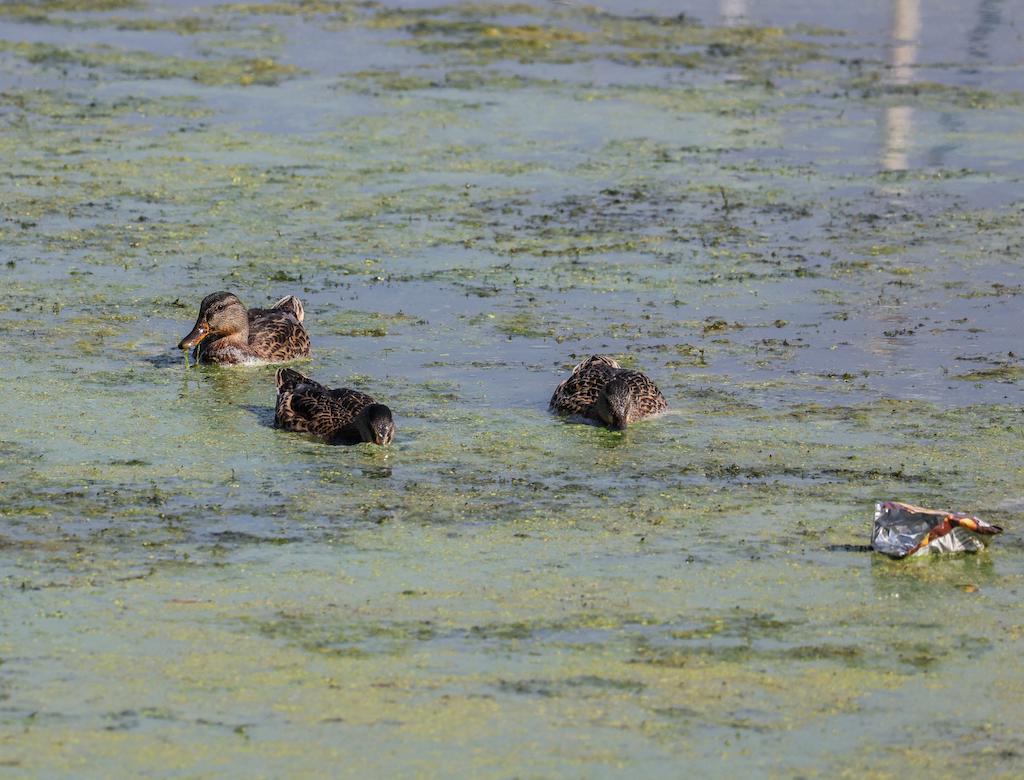
Orr says that taking Lough Neagh into public ownership would be one good step to tackle the situation. The bed and soil of Lough Neagh is currently owned by the Earl of Shaftesbury’s estate.
A petition to bring the lough into public ownership and manage it under a single body was submitted to the UK parliament last month. This was rejected.
Nicholas Ashley-Cooper, who currently holds the title of Earl of Shaftesbury, told BBC News that he is willing to sell the lake to the public – “but won’t give it away for free”.
Orr says that if a functioning devolved government had been in place in recent months, there could have been closer scrutiny of politicians, civil servants and the bodies responsible for protecting the environment. But, he adds:
“The system has just got its hands over its ears…[This is] going to happen again and again and again, and it’s going to happen for decades unless we do the obvious thing – reduce the pollution and invest in sewage infrastructure.”
The post Lough Neagh: How climate change intensified toxic algae on the UK’s largest lake appeared first on Carbon Brief.
Lough Neagh: How climate change intensified toxic algae on the UK’s largest lake
Climate Change
Fossil-fuelled heat has caused tropical birds to decline by ‘up to 38%’ since 1950s
An uptick in heat extremes, driven by human-caused climate change, has caused tropical bird populations to decline by up to 38% since the 1950s, according to a first-of-its-kind analysis.
The study combines ecological and climate attribution techniques to trace the fingerprint of fossil-fuelled climate change on declining wildlife populations.
It shows that an increase in heat extremes driven by climate change has caused tropical bird populations to decline by 25-38% in the period 1950-2020, when compared to a world without warming.
The findings could help to explain why tropical bird numbers have declined even in pristine rainforests, a phenomenon that previously mystified biologists, the scientists say.
‘Chance encounter’
Over the past few decades, an emerging field of science known as “climate attribution” has used a standardised set of techniques to trace the fingerprint of human-caused warming on different elements of the climate system, ranging from worsening extreme weather events to episodes of glacier melt.
The new research, published in Nature Ecology and Evolution, is the first to use climate attribution techniques to detect the fingerprint of climate change on declining wildlife populations.
The study came about following a “chance encounter” between lead author Dr Maximilian Kotz, a climate scientist at the Barcelona Supercomputing Center in Spain, and his co-authors, who are biodiversity experts at the University of Queensland in Australia, while Kotz was completing a research stay in Australia.
Kotz says to Carbon Brief:
“As far as we are aware, this is the first animal climate attribution study.”
The researchers decided to focus on birds, rather than other animal species, as they have the “best available data, covering a good range of different species and geographies”, he adds.
Heat extremes
The authors examine how an intensification of heat extremes could have impacted bird populations, while controlling for other factors known to affect wildlife, including average temperature increase and human pressures, such as land-use change.
Episodes of extreme heat are known to have an immediate and long-lasting impact on birds, Kotz says:
“High temperature extremes can induce direct mortality in bird populations due to hyperthermia and dehydration. Even when they don’t [kill birds immediately], there’s evidence that this can then affect body condition which, in turn, affects breeding behaviour and success.”
Using statistical techniques, the scientists first analyse historical records to identify how bird populations have responded to fluctuations in climate, including heat extremes, over 1950-2020.
The team sourced global data on bird populations from the database that underlies the Living Planet Index, put together by the environmental charity WWF. They note it is the most comprehensive database available, but still has “clear geographic biases”, with global north regions better represented than those in the global south.
They use an attribution framework to estimate the extent to which human-caused warming influenced the changes in heat extremes observed in that time period, then calculate the impact of these climate-change-driven heat extremes on bird population changes from 1950-2020.
(The authors defined “heat extremes” as temperatures within the top 1% of daily temperatures over 1940-70, with data taken from ERA5, a global reanalysis dataset, which combines data from weather stations, satellites and model output.)
To understand how this would compare to a world without climate change, the researchers subtract this impact from the historical records.
Comparing their results to the counterfactual world without climate change allowed them to quantify how bird populations have changed as a result of human-driven increases in heat extremes.
Mapped
The research finds that human-driven heat extremes have had “strong negative impacts” on bird population numbers, with those residing at lower latitudes being the most affected.
The map below shows the percentage change in bird population abundance attributed to heat extremes over 1950-2018, when compared to a world without climate change.
On the map, dark red shows large decreases in population abundance, while light blue indicates small increases. (Abundance refers to the number of individual animals in a given population.)
The research finds that birds in the tropics have experienced the largest declines attributable to heat extremes.
It concludes that an uptick in heat extremes has caused tropical bird abundance levels to decline by 25-38% in the period 1950-2020, when compared to a world without warming.
The range in the size of that impact reflects the results of different models, which each use slightly different techniques to simulate changes to bird populations, Kotz says.
Tropical turmoil
In their paper, the authors note that their finding that tropical birds have experienced the most substantial declines are “consistent” with other studies indicating that “birds in these regions may be closer to the thermal limits at which impacts start to occur”.
They add that the findings are “particularly pertinent, given recent documentation of declining tropical bird populations, even in undisturbed habitats”.
One previous study found that in a “relatively undisturbed” part of the Amazon rainforest, bird abundance declined by more than 50% from 2003 to 2022. Similar results were found in a forest in Panama.
The authors of the new study say:
“The source of such declines have been noted as unknown, yet they are of a similar order of magnitude to our estimates of the impacts of intensified heat extremes.”
Their results suggest that “in tropical realms, climate change impacts on bird populations may already be comparable to land pressures that lead to habitat destruction and degradation”, the authors say.
This has “potential ramifications” for commonly proposed conservation strategies, such as increasing the amount of land in the the tropics that is protected for nature, they continue:
“While we do not disagree that these strategies are necessary for abating tropical habitat loss…our research shows there is now an additional urgent need to investigate strategies that can allow for the persistence of tropical species that are vulnerable to heat extremes.”
In some parts of the world, scientists and conservationists are looking into how to protect wildlife from more intense and frequent climate extremes, Kotz tells Carbon Brief.
He references one project in Australia which is working to protect threatened wildlife following periods of extreme heat, drought and bushfires.
Informing forecasts
As well as shedding light on what could be behind the rapid decline of birds in the tropics, the findings also underscore the importance of examining changes in climate extremes, rather than just annual global temperature rise, says Prof Alex Pigot, a biodiversity scientist at University College London (UCL), who was not involved in the research. He tells Carbon Brief:
“Most of the models that have been used to make projections of risk to biodiversity under future climate change use long-term climate averages and so the results of this study suggest that our existing risk assessments could be missing these critical impacts of climate change.
“We urgently need to address this and develop early warning systems to be able to anticipate in advance where and when extreme heatwaves and droughts are likely to impact populations – and also rapidly scale up our monitoring of species and ecosystems so that we can reliably detect these effects and feed this information back into our models to refine our future projections for biodiversity.”
Dr Peter Soroye, a biodiversity scientist at the Wildlife Conservation Society Canada, who was also not involved in the research, agrees:
“It’s not just that the climate is getting gradually warmer every year with climate change, it’s that climate change is also driving increasingly frequent and severe extreme temperature events that are putting wildlife at risk.
“As we more fully understand the importance of extremes, it seems increasingly important to consider them when we model or project changes in biodiversity over time.”
The post Fossil-fuelled heat has caused tropical birds to decline by ‘up to 38%’ since 1950s appeared first on Carbon Brief.
Fossil-fuelled heat has caused tropical birds to decline by ‘up to 38%’ since 1950s
Climate Change
COP experts: How could the UN climate talks be reformed?
This year marks a decade since nations successfully negotiated the Paris Agreement, a landmark treaty that has been the guiding force for international climate politics ever since.
Yet, with another round of negotiations looming at COP30 in November, there has been growing discontent with the UN climate process.
Critics say the talks are not doing enough to accelerate emissions cuts, tackle fossil fuels or raise climate funds for developing countries, among other concerns.
Influential figures in climate politics and civil society groups say COPs are in need of an “urgent overhaul” and have launched various manifestos for change.
This has been recognised by the Brazilian COP30 presidency, which has acknowledged the “growing calls for change” and asked parties to “reflect on the future of the process itself”.
All of this comes amid concerns about a “crisis” of multilateralism, widespread conflict and escalating climate hazards.
Carbon Brief asked 16 leading experts about how they think the UN climate talks could be reformed, including Christiana Figueres, Todd Stern, Prof Navroz K Dubash, Bernice Lee, Paul Watkinson, Dr Joanna Depledge, Dr Jennifer Allan, Sandrine Dixson-Declève and Li Shuo.
The contributors’ answers are presented via the thematic sections below.
- Has the Paris Agreement been a success?
- How could the negotiations themselves be improved?
- Can UN climate talks drive faster emissions cuts?
- How could COPs ensure broader accountability?
- Do UN climate talks need majority voting?
- What should the role of the COP presidency be?
- Do fossil-fuel companies have too much influence?
- Are COPs too big?
- How could COP participation be improved?
- How can COPs drive change outside the UN process?
Has the Paris Agreement been a success?
Todd Stern, former US special envoy for climate change: Paris has performed well in some respects, including strengthening both its temperature and emission goals in light of evolving science. It also led to a first global stocktake that called for tripling renewable energy and doubling energy efficiency by 2030 – and transitioning away from fossil fuels – in order to achieve net-zero emissions by 2050.
Bernice Lee, distinguished fellow and senior advisor at Chatham House: It can be hard to remember that the process remains one of the most successful multilateral endeavours in recent history. It has delivered what few thought possible: agreement among nearly 200 countries on a global issue that cuts to the core of national sovereignty, economic models and domestic politics. That the COP process delivered the Paris Agreement – and more recently, an agreement to transition away from fossil fuels – is no small feat. It is also easy to forget that, prior to Paris, the world was on track for a catastrophic 4-5C of warming. Today’s pledges, while still inadequate, have bent that curve closer to 2.5-3C – still unsafe, but a meaningful shift…Rather than dwelling on the system’s imperfections, the question is whether it can evolve, realistically and politically. Dismantling the current system is unlikely to yield a stronger or more equitable one with the authority to override national decisions. The current process, after all, emerged from the ruins of earlier failures.
Kaveh Guilanpour, vice president for international strategies at the Centre for Climate and Energy Solutions: In the aftermath of every COP, there are calls to reform the UNFCCC. But we should be aiming for an evolution, not a revolution, for three reasons. Firstly, a revolution would almost certainly not result in something stronger than we already have. It is hard to imagine that it would be possible to adopt the Paris Agreement in the current geopolitical and economic context. Secondly, the Paris Agreement is working, albeit not fast enough. Thirdly, and most importantly, the biggest barriers to the effective functioning of the UNFCCC and delivering on the Paris Agreement are deficiencies in the underlying politics. No amount of tweaking of the UNFCCC process can make up for that.
How could the negotiations themselves be improved?
Dr Monserrat Madariaga Gomez de Cuenca, environmental lawyer at Legal Response International: It is time to fully acknowledge that there is a crisis of trust in the UN climate process and take appropriate measures to limit it. Parties mistrust each other and stakeholders mistrust the limited results emerging from 30 years of climate talks.
Paul Watkinson, former EU climate negotiator: Whilst the negotiating process can be frustrating, it remains essential. I would focus on making the workload more manageable, for example by grouping items on agendas and organising work on a multiannual basis. The aim should be to give enough time to every item – rather than addressing everything together each time – and develop the understanding that not every item needs a negotiated outcome at each meeting.
Kaveh Guilanpour: [We should] embrace the role of multilateral negotiations at the core – and recognise that this is what attracts world leaders and non-parties to COPs – but work towards contextualising the negotiations in a wider ecosystem of climate action, to which they are clearly linked. Do not place all expectations only on the negotiated outcomes.
Christiana Figueres, former executive secretary of the UNFCCC: We could…streamline repetitive and overloaded agendas – and elevate the accountability of COP presidents through a public oath of office, potentially administered by the UNFCCC bureau, that reminds the COP presidency of its role.
Dr Joanna Depledge, research fellow at the University of Cambridge and former UNFCCC secretariat staff member: Overall, the negotiations have proved resistant to anything but very limited reform. Why so? The fact is that many of the perceived inefficiencies are not flaws as such, but inherent to a global process where all nations are sovereign and equal – and all want a say. They are also inherent to the very issue of climate change, which, because it is so multifaceted…inevitably spawns an ever-expanding agenda, while attracting ever more government and civil society participants. And process is politics: moves to restructure the negotiations inevitably come up against powerful forces who know how to maximise their influence in the existing system and far prefer the status quo.
Dr Monserrat Madariaga Gomez de Cuenca: [COPs should] avoid rushed, closed-door negotiations without party consultations, which make implementation impossible. When draft text appears in the eleventh hour and is forwarded to the closing plenary without proper discussion, the possibilities of parties gaslighting each other on the actual “meaning” and “intention” of the text multiply. Language such as “transitioning away from fossil fuels” or the path towards the “Baku to Belém Roadmap to $1.3tn” – where the wording is not clear – allows parties to cherry-pick the most favourable interpretation, undermining the implementation of decisions that were already difficult to achieve.
Dr Joanna Depledge: Streamlining agendas and limiting government delegation size are worth fighting for, but imposing criteria for selecting COP hosts and excluding private companies involved in high-carbon activities are non-starters. If the real problem is that the COP is not taking decisions in line with the science, then the answer is not tinkering around the edges of procedure and process. What is needed is a major strategic rethink and more fundamental reforms – notably to decision-making practices and voting – as I argue elsewhere.
Harjeet Singh, founding director at the Satat Sampada Climate Foundation: The process must change: streamline negotiations, review consensus rules and ban fossil-fuel lobbyists from influencing texts. Centre the voices of Indigenous peoples, frontline communities and civil society. And scale up public climate finance to enable a just transition and real support for adaptation and addressing loss and damage – by making polluters pay. The recent International Court of Justice advisory opinion has reinforced the demand for climate reparations. COP30 must open a new era of accountability and justice.
Can UN climate talks drive faster emissions cuts?
Dr Jennifer Allan, senior lecturer in international relations, Cardiff University: The UNFCCC is only as effective as parties allow it to be. The Paris Agreement is working precisely how some feared and how some major emitting countries hoped. It is premised on the promise of transparency: that national reports and the global stocktake, coupled with principles of progression, will – somehow – inspire climate ambition. But transparency is not the same as accountability.
Todd Stern: The Paris regime itself has an important role to play. For starters, the regime needs to develop much more of a broad partnership in the spirit of the 2015 High Ambition Coalition. Part of such a shift will depend on considering whether country emission targets are adequate. Of course, Paris was built on the principle of “nationally determined contributions” and that principle cannot be thrown overboard. But Paris was also built on the promise that it would strive to prevent dangerous climate change, that new emission targets every five years would reflect countries’ highest possible ambition and that global stocktakes would, in fact, take stock.
Claudio Angelo, head of international policy at the Climate Observatory: The “nationally determined” nature of nationally determined contributions (NDCs), and the fact that no assessment of progress is formally done outside the five-year period of the global stocktake, mean that the ambition gap will become more difficult to close the more urgent it becomes to close it. The irony of it is that the Paris architecture was tailor-made to accommodate the idiosyncrasies of the US, which has pulled out of the agreement anyway.
Prof Navroz K Dubash, professor of public and international affairs at Princeton School of Public and International Affairs: A bumper sticker for reform of the UN climate talks might read: “Less talk of ambition; more action on implementation”. An “ambition-first” approach rests on extracting national statements of emissions reduction intent, leveraging these up through country “naming and shaming” and strengthening compliance through enhanced accountability. But the conditions are not favourable for this approach. National politics rarely privilege emissions reductions over other objectives and global politics is increasingly non-responsive to climate shame. By contrast, the conditions for a “learning-by-doing” approach based on on-the-ground implementation appear brighter. Many countries are experimenting with pragmatic efforts to turn their economies in low-carbon directions.
Todd Stern: There is nothing about the nationally determined character of country pledges that says countries cannot be questioned, prodded and critiqued. Protecting thin skin is not as important as protecting a liveable world.
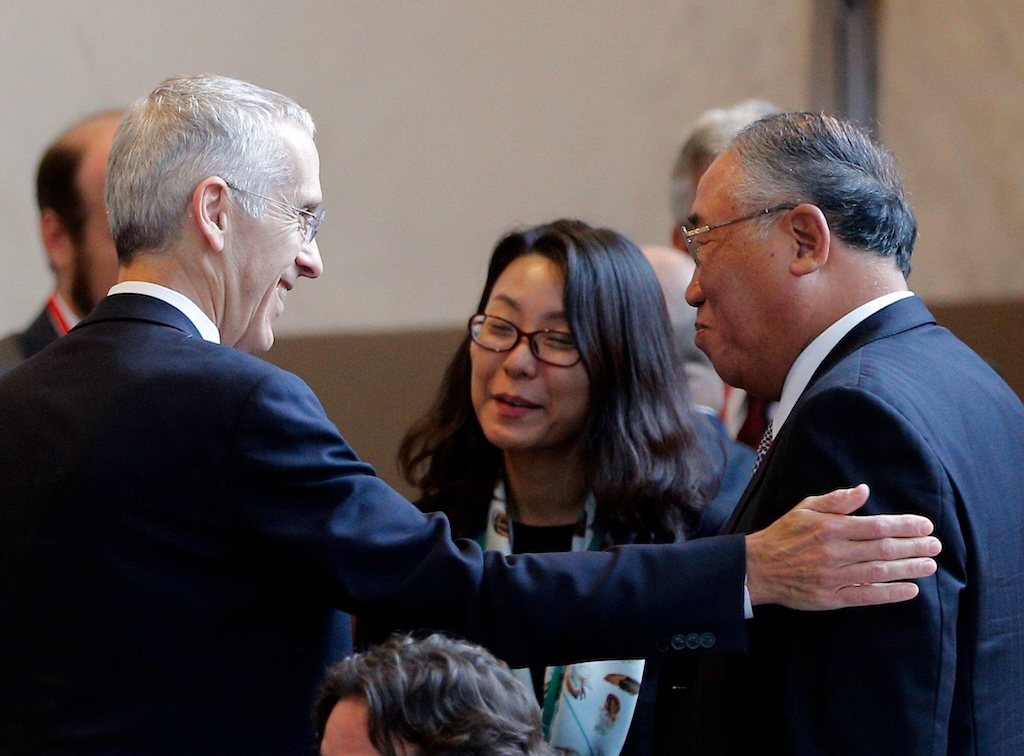
Prof Navroz K Dubash: How might global talks enable learning by doing, rather than doubling down on ambition-first approaches? NDCs could be liberated to be templates for experimentation rather than rigid bases for accountability alone. Detailed sectoral low-carbon development pathways would highlight country commonalities, reveal productive scope for international cooperation and incentivise finance…A renewed international process should be focused on the hard, detailed work of enabling low-carbon, resilient development transitions and less on extracting statements of intent.
Kaveh Guilanpour: [We should] move to an approach where progress is measured predominantly by the impact of implemented national level policies, not NDCs on paper. Focus as much on enhancing international cooperation to deliver implementation as on increasing formal ambition on paper through NDC target-setting.
How could COPs ensure broader accountability?
Paul Watkinson: The biggest opportunity to support implementation is outside the formal process, putting order and structure into the “action agenda”. It has grown enormously in recent years and there have been many valuable initiatives…But there has been insufficient continuity and not enough follow-up and tracking to ensure that what is announced and promised is delivered. That is why I welcome the proposal of the incoming Brazilian COP30 presidency to structure the action agenda around six broad themes, drawn from the outcomes of the global stocktake, including a cross-cutting theme around enablers including the vital role of finance. They have the power, in close coordination with the high-level champions, to relaunch the action agenda on stronger foundations that could serve for years to come.
Dr Jennifer Allan: Within the negotiations, there is a glaring need to track the many commitments made outside of the regular negotiation process, either in presidency-led declarations or cover decisions. A central, publicly available hub needs to collate these promises and track progress. Presidencies may broker these commitments, but have few incentives to follow up on them.
Bernice Lee: What can – and must – change is how the system functions. Every decade or so, the climate regime has adapted – from Kyoto’s top-down legalism to Paris’s nationally determined flexibility. These shifts were not just philosophical, they also enabled new capacities. The collapse in Copenhagen helped catalyse renewable energy investment plans, while Paris introduced NDCs. The next phase must embed delivery and equity more deeply into the process including, for example, mechanisms aligning corporate transition plans with country transition, national policies and sectoral pathways. The outcomes of any reform process should mean fewer theatrics, earlier decisions and sharper accountability. All of this would enhance not only country but also public engagement, as well as the credibility of the global climate process.
Harjeet Singh: Rather than catalysing ambition, the Paris Agreement has been used by developed countries to shirk their historical responsibilities…It is not the Paris Agreement or the UNFCCC that failed – it is rich countries that undermined the system to protect polluters and preserve an unsustainable growth model. True reform begins with accountability. Wealthy nations must be held responsible for their historical emissions and must pay for the loss and damage they have caused.
Sandrine Dixson-Declève, honorary president at the Club of Rome and executive chair of Earth4All: Strengthen climate target enforcement through scientific oversight, peer review and robust reporting – ensuring governments, COP presidencies and corporations are held accountable. [There should be] a permanent scientific advisory body within the COP. Science must be central to negotiations, with all delegations regularly briefed on the latest data around risks, equity, solutions and scenarios.
Prof Navroz K Dubash: Ambition and implementation can be complementary, but they are not necessarily so. The former is driven by a relentless focus on emissions, comparability in emission pledges and building accountability. The latter is enabled by linking climate to other objectives, seeking country-specific formulations that buy political support and flexible experimentation that allows for learning from failure. Being more, not less, in the sectoral weeds might reveal opportunities not apparent from the stratospheric heights of climate negotiations. Well-developed, home-grown visions of sustainable futures are the most robust basis for developing countries’ legitimate claims for finance and other support.
Do UN climate talks need majority voting?
Erika Lennon, senior climate attorney at the Centre for International Environmental Law: Voting is the elephant in the room. The parties to the UNFCCC have never been able to adopt the “rules of procedure” because they cannot agree on the provision related to voting in the absence of consensus. Instead, they proceed meeting after meeting using them as “draft rules of procedure”. This has created a race to the bottom whereby countries that want to stall progress can do so. For 29 years, other parties have had to agree to the lowest common denominator in the name of consensus.
Claudio Angelo: The decision made in 2023 to “transition away from fossil fuels” needs both fleshing out and monitoring, but it is nowhere to be seen in the formal negotiations towards Belém. Such omissions reflect one fundamental problem of the UNFCCC and one fundamental flaw of the Paris Agreement: the consensus rule. Some countries are now shamelessly backtracking on their previous commitment and saying that any mention of cutting back on fossil fuels anywhere is a red line for them…A handful of countries are holding the future of humanity hostage because they can block whatever they want [due to the consensus rule]. Even COP presidencies that do want to move the agenda forward are afraid to be bold, lest “the process should collapse”. But a process that is unfit for purpose might as well collapse.
Christiana Figueres: In the context of the formal negotiations, we could reconsider our tradition of having to adopt all decisions unanimously. UNFCCC procedures require consensus for the adoption of decisions, not necessarily unanimity. The difference is important and admittedly challenging to manage, but worth examining.
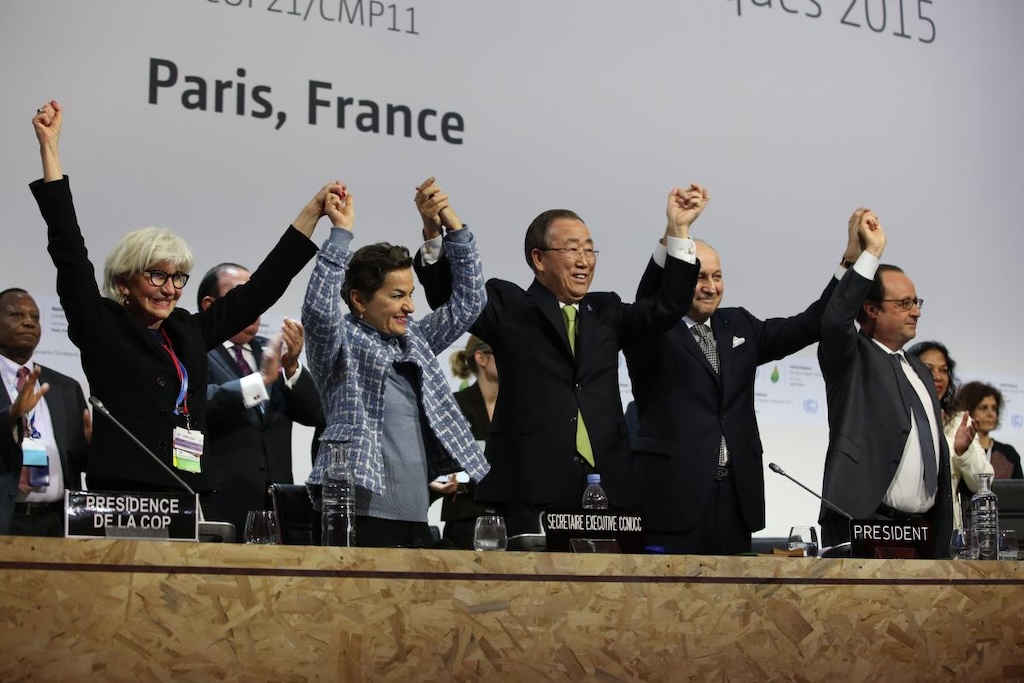
Erika Lennon: The fix would be to adopt the rules of procedure, including the paragraphs on voting. The UNFCCC would then join many other multilateral environmental agreements – and its own financial instruments – that sometimes use majority voting.
Bernice Lee: In recent months, many well-meaning critics have called the UN multilateral climate process broken, arguing it should be dismantled and replaced, but with no viable alternatives waiting in the wings. Reforming core procedures – such as introducing majority voting or amending the convention – would require agreement from three-quarters of countries, followed by domestic ratification. Even without today’s fractured geopolitics, this would be a tall order.
What should the role of the COP presidency be?
Dr Monserrat Madariaga Gomez de Cuenca: [COPs should] avoid adding more pressure by clarifying duties and processes for the COP president. Rules of procedure simply give the COP president the power to formally conduct the negotiations, which should be done in a neutral manner. Increasingly, we see COP presidents setting exceedingly ambitious plans for their respective COPs. Ideas of “success” and “legacy” permeate what should be a facilitative role towards the collective progress of UN climate talks. COPs finish with statements and reports of achievements that do not reflect the actual progress. Reviewing the conduct of negotiations and the role and expectations of COP presidencies could help in restoring some of the damaged trust in the process.
Prof Thomas Hale, professor in public policy at the University of Oxford: The “action agenda” needs to escape the “boom-bust” cycle that shifting presidencies and high-level champions have imposed on it, in which new announcements trump delivery. The COP30 presidency has laid out a positive approach here, but the acid test lies in making it real.
Sandrine Dixson-Declève: Only countries with high climate ambition should be eligible to host COPs.
Li Shuo, director of the China Climate Hub at the Asia Society Policy Institute: Instead of – or alongside – three more paragraphs specifying how the world will “transition away from fossil fuels” or “triple renewable energy”, how about three renewable projects in the COP host country, to be announced in conjunction with the climate summit?…Efforts to advance the implementation agenda through additional multilateral rulemaking and COP decisions risk missing the point. The COP presidency…could showcase a handful of large‑scale renewable energy projects in their own countries, backed by concrete financing. Such a “trade fair” function of the COP would help bridge the widening gap between what is agreed at COPs and what is happening on the ground.
Do fossil-fuel companies have too much influence?
Erika Lennon: The fossil fuel industry’s survival depends on the UNFCCC’s failure, as meeting the goals of the UNFCCC and Paris Agreement undeniably means phasing out fossil fuels. It is therefore no wonder that, since the beginning, fossil-fuel industry lobbyists have been present at COPs and working to undermine ambition.
Dr Jennifer Allan: Presidencies have much to answer for and can be key to raising accountability. COP is becoming the new Davos: a place for billionaires to meet, without scrutiny of their activities or announcements. This must end. Presidencies should revoke invitations to [Amazon chief executive] Jeff Bezos and others who have been offered high-level platforms.
Erika Lennon: Parties could adopt a conflict-of-interest policy to, at the very least, make [fossil-fuel lobbyists’] influence transparent and subsequently exclude those who aim to unduly influence the process. Parties, including the presidency team, could refuse to give them badges…In addition, they could end greenwashing at COPs in the form of corporate sponsorships and pavilions.
Are COPs too big?
Prof Thomas Hale: COP is both too big and too small for an era of implementation. Its cost and complexity eat up scarce resources. Meanwhile, it creates a gravity well that warps the climate community’s work into an annual rush to the end of the year…At the same time, even the biggest COPs are puny compared to the problem. Climate change demands action from all of society…In this complex system, the UNFCCC process plays the critical function of setting agendas and goals. No other body has the multilateral legitimacy to serve as a lighthouse.
Dr Jennifer Allan: Climate summits could shift from a talkshop to a demonstration of leadership if invitations are only extended to countries that have submitted and maintained more progressive NDCs and are implementing them.
Prof Thomas Hale: We need COPs to be everything, everywhere, all at once. Alongside a single, two-week meeting in one place, we need lots of smaller, focused meetings in many places. Instead of an intergovernmental process that talks about action, we need to fully shift the “action agenda” into the heart of the UNFCCC. The good news is that the elements of this shift are already well in motion, with more and more cities hosting “climate weeks”…Regional meetings with more flexible formats reach more people, in a more targeted way, much more cheaply and efficiently than a COP.
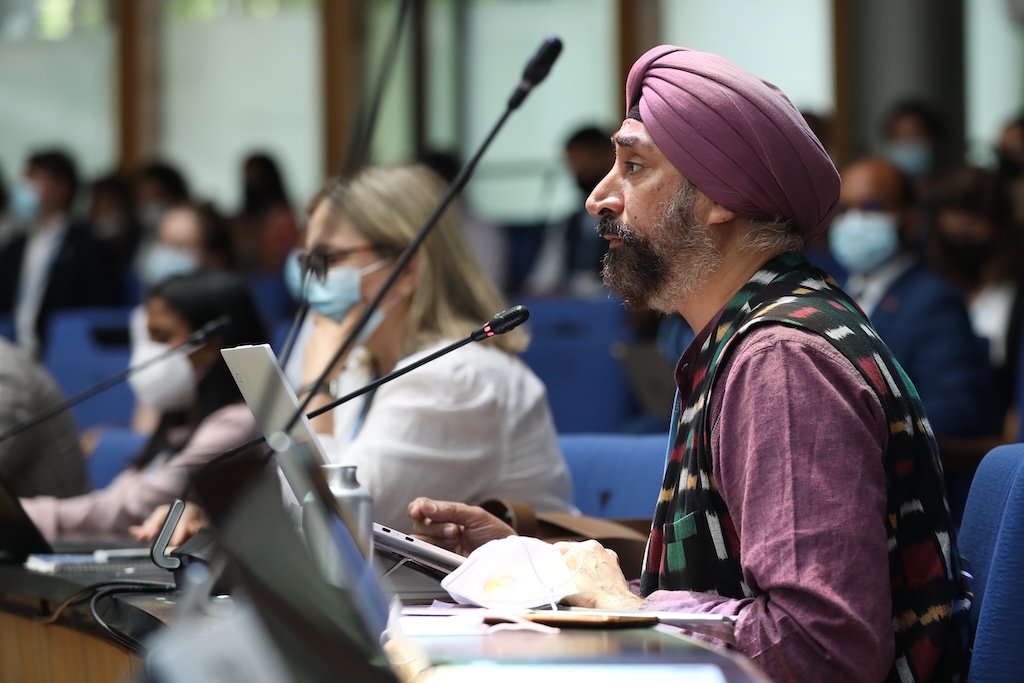
Dr Jennifer Allan: I’ve been researching the role of side events, pavilion activities and Global Climate Action Hub panels in the “expo” that now dominates COP space and participation opportunities. There has been a decided shift, from a smaller number of events focused on negotiation and implementation to a huge array of panels showcasing new initiatives or national actions. It is about what is new, not following up on what has been agreed. Side events and Global Climate Action Hub events could shift focus under the secretariat and the high-level champions. Pavilion spaces could be reserved for those who can demonstrate that their presence will advance climate action.
Sandrine Dixson-Declève: COPs must evolve from negotiation-heavy forums to more frequent, smaller, solution-focused meetings centred on progress and implementation, with broad stakeholder participation.
How could COP participation be improved?
Erika Lennon: Civil society, youth, Indigenous peoples, women, local communities and people with disabilities, among others, have increasingly faced shrinking civic space in the UNFCCC process. They have to fight to have their voices heard, to be present in the rooms where decisions happen, for access to information and open decision-making, and to assemble peacefully.
Shreeshan Venkatesh, global policy lead at Climate Action Network International: Structural barriers…undermine inclusivity and equitable participation in UNFCCC meetings, from the high cost of accommodation at COPs to discriminatory visa practices and shrinking civil society quotas. These barriers must be dismantled to ensure all parties and stakeholders can participate fully and on equal terms.
Erika Lennon: Parties should incorporate and support participation not only at COPs, but also in climate action and decisions on the ground. They can do this by creating space across all agenda items to hear from rightsholders and ensuring human rights and civic space are guaranteed during all negotiations.
Shreeshan Venkatesh: Civic space and freedoms are under threat, even at COPs. Host agreements must guarantee freedom of speech, assembly and accessibility, backed by an independent body to address violations.
How can COPs drive change outside the UN process?
Sandrine Dixson-Declève: COP must transform from a forum of negotiation to a platform of delivery, inclusion and accountability, anchoring climate action in the lived realities of people and the demands of science.
Kaveh Guilanpour: There should be a thorough and honest analysis of the value add of the UNFCCC process and what is best left to other fora.
Christiana Figueres: While some negotiations remain necessary, the most urgent action has shifted to implementation in the context of market forces and climate economics. There is no doubt that civil society, businesses, cities and communities are moving faster than governments. These actors, traditionally considered and labelled as mere “observers” in the formal UNFCCC space, have become the true engines of transformation. One could consider the pros and cons of creating a semi-detached “real world” space alongside COP – one that amplifies their progress, showcases innovation and feeds actionable insights back into the formal process.
Todd Stern: The Paris regime has a role to play in encouraging and tracking strong action outside its purview. This includes the public and private sectors working together on rapid decarbonisation and on unlocking the kind of large-scale investment needed for countries in the global south to build sustainable and resilient economies.
Shreeshan Venkatesh: The UNFCCC, and other multilateral fora that have become central to the formulation and implementation of climate policy and international cooperation, must align with international law. This includes the recent advisory opinions from the ICJ and the Inter-American Court of Justice, and the obligations they clearly lay out.
Claudio Angelo: [There is] a final, bigger problem, which no UNFCCC reform can solve: the climate regime is a child of the democratic world order and the lynchpin of that world order has become a rogue state. The rise of the far-right and the erosion of democracy are rendering multilateralism itself useless – a world that is unable to stop genocides in Gaza and Sudan can’t solve the climate crisis.
The post COP experts: How could the UN climate talks be reformed? appeared first on Carbon Brief.
Climate Change
Analysis: Record UK wildfires have burned an area twice the size of Glasgow in 2025
Wildfires have scorched more than 40,000 hectares of land so far this year across the UK – an area more than twice the size of the Scottish city of Glasgow.
This is already a record amount of land burned in a single year, far exceeding the previous high, Global Wildfire Information System (GWIS) data shows.
It is also almost four times the average area burned in wildfires by this stage of the year over 2012-24 – and 50% higher than the previous record amount burned by this time in 2019.
The burned area overtook the previous annual record in April, BBC News reported at the time, and has continued to soar in the months since.
Major wildfires
The chart below shows that UK wildfires in 2025 so far have already burned by far the largest area of land over any calendar year since GWIS records began in 2012. The previous record year was 2019, followed by 2022, while 2024 saw the lowest area size burned.

Annual land area burned by wildfires across the UK from 2012 to 2025 (red), alongside the average area burned each year over 2012-24. Source: Global Wildfire Information System.
Climate change can increase the risk and impact of wildfires. Warmer temperatures and drought can leave land parched and dry out vegetation, which helps fires spread more rapidly. Climate change is making these types of extreme conditions more likely to occur, as well as more severe.
Fire services in England and Wales responded to 564 wildfires from January to June 2025 – an increase from 69 fires in the same period last year, the National Fire Chiefs Council (NFCC) said in a statement in June.
Most wildfires in the UK are caused by human activity, whether accidental or deliberate, according to the NFCC. Some common ignition sources are disposable barbecues, lit cigarettes and campfires.
Jessica Richter, a research analyst at Global Forest Watch, says that, while fires are also a key part of some ecosystems, climate change is the “major driver behind the increasing fire activity around the globe”. She tells Carbon Brief:
“As we see more fires, we’re going to see more carbon being emitted and that’s just going to be, for lack of a better phrasing, adding fuel to the fire.”

Examples of 2025 wildfires around Galloway (1) and Inverness (2) in Scotland, and a wildfire in Powys (3) in Wales. Source: FIRMS, MapTiler, OpenStreetMap contributors.
The UK has also recorded its highest-ever wildfire emissions this year, according to Copernicus, which was “primarily driven” by major wildfires in Scotland from late June to early July.
These were the largest wildfires ever recorded in the country, reported the Scotsman. They “ravaged” land in Moray and the Highlands in the north of the country, the newspaper added.
Scotland experienced an extreme wildfire in Galloway Forest Park in April, which was “so intense it could be seen from space”, the Financial Times said.
Elsewhere, in April, the Belfast News Letter reported that firefighters tackled almost 150 fires on the Mourne Mountains in Northern Ireland.
More recently, BBC News reported that firefighters in Dorset, England received “non-stop” wildfire calls in the first weekend of August, with one blaze “engulf[ing] an area the size of 30 football pitches”.
Wildfires have also caused devastation across many parts of Europe in recent weeks – including Albania, Cyprus, France, Greece, Spain and Turkey – as well as in the US and Canada.
The post Analysis: Record UK wildfires have burned an area twice the size of Glasgow in 2025 appeared first on Carbon Brief.
Analysis: Record UK wildfires have burned an area twice the size of Glasgow in 2025
-
Climate Change2 years ago
Spanish-language misinformation on renewable energy spreads online, report shows
-
Climate Change Videos2 years ago
The toxic gas flares fuelling Nigeria’s climate change – BBC News
-

 Greenhouse Gases1 year ago
Greenhouse Gases1 year ago嘉宾来稿:满足中国增长的用电需求 光伏加储能“比新建煤电更实惠”
-

 Climate Change1 year ago
Climate Change1 year ago嘉宾来稿:满足中国增长的用电需求 光伏加储能“比新建煤电更实惠”
-

 Carbon Footprint1 year ago
Carbon Footprint1 year agoUS SEC’s Climate Disclosure Rules Spur Renewed Interest in Carbon Credits
-
Climate Change2 years ago
Why airlines are perfect targets for anti-greenwashing legal action
-
Climate Change Videos2 years ago
The toxic gas flares fuelling Nigeria’s climate change – BBC News
-
Climate Change2 years ago
Some firms unaware of England’s new single-use plastic ban










